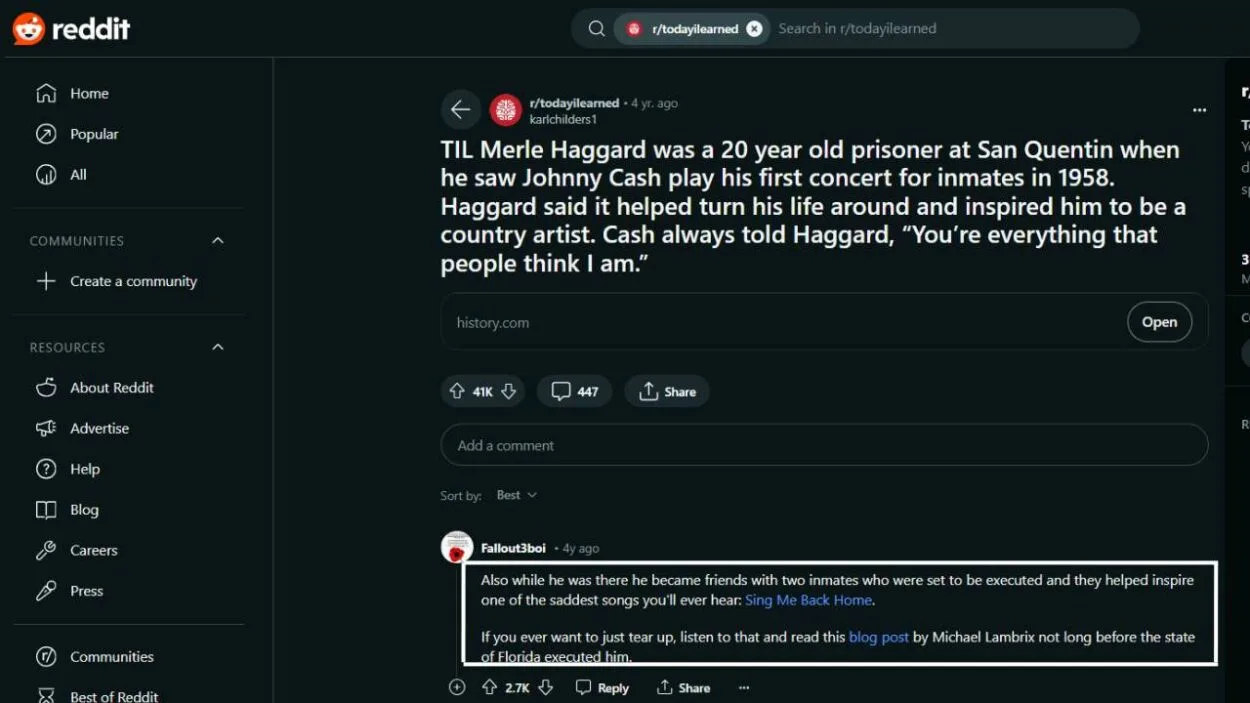Merle Haggard, a name synonymous with outlaw country music, had a life far more complex than his rough-and-tumble persona might suggest.
His journey to becoming a country music legend took an unexpected turn in 1957 when a botched robbery landed him in San Quentin, California’s notorious prison.
It was within these harsh walls that Haggard not only discovered a passion for music but also encountered experiences that would shape one of his most haunting and enigmatic songs, “Sing Me Back Home.”
This ballad, with its tale of a condemned man’s final request, resonates deeply with listeners, but the true source of its inspiration remains a captivating mystery.
Haggard’s Time at San Quentin (The Context of the Song)
Merle Haggard‘s troubles started early due to poverty and limited opportunities. His rebellious nature led to petty crimes, culminating in an ill-fated robbery at a Bakersfield roadhouse in 1957.
It wasn’t a sophisticated crime; rather, it seemed like a desperate attempt for quick cash, but it ended in failure.
San Quentin prison, where Haggard ended up, was a harsh reality check. Cells were overcrowded, hot, and smelled of despair.

Violence lurked everywhere, with constant threats and tensions. Despair hung heavy, with broken dreams and uncertain futures haunting the inmates.
Amidst this bleakness, Haggard found solace in music. Whether he had prior musical experience or discovered it in prison is unclear.
Perhaps he found an old guitar in the yard and started strumming, or he joined a prison band for comfort.
Music became his lifeline, helping him express emotions and dreams beyond prison walls. However, San Quentin also exposed him to death row, adding a haunting layer to his experiences.
This eerie encounter may have influenced his song “Sing Me Back Home,” connecting his musical journey with the darker realities of life behind bars.
Inspiration for the Song
Merle Haggard’s time at San Quentin exposed him to the grim reality of death row, where two inmates, Caryl Chessman and James “Rabbit” Kendrick, may have influenced his song “Sing Me Back Home.”
Caryl Chessman, known for his controversial case and capital punishment reform advocacy, was on death row for non-lethal crimes.
Haggard might have witnessed Chessman’s persistent belief in his innocence or his despair as his execution approached.
James “Rabbit” Kendrick, with his daring escape and tragic shootout, may have resonated more directly with the song’s themes. Rabbit’s charismatic or rebellious personality and his tragic end could have left a lasting impact on Haggard.
The central question arises: Were Chessman and Rabbit the inspiration for “Sing Me Back Home”? Chessman’s struggle for life and pleas for clemency, or Rabbit’s emotional turmoil before his execution, might have sparked Haggard’s creativity.
The song’s theme of longing for home and simpler times aligns with Chessman’s and Rabbit’s situations, adding ambiguity to the song’s origins and leaving room for speculation about its true inspiration.
The Song’s Narrative
“Sing Me Back Home” isn’t just a song; it’s a story that brings us into a prison setting filled with emotions and perspectives.
The song is told from the viewpoint of a fellow inmate who shares a bond with a man facing his final moments.
The narrator struggles with the weight of witnessing such a tragic event, feeling powerless to help yet empathizing with the condemned man’s plight.
As the condemned man walks towards his fate, he asks for a song from the narrator, seeking solace in his final moments.
This request weighs heavily on the narrator, who sees it as a desperate attempt to offer comfort or a final act of defiance against the harsh reality of prison life.
The chosen song, perhaps a familiar tune from their past, evokes memories of home – a place of comfort and innocence.
It transports both men back to a time before mistakes were made, offering a fleeting escape from their current situation.
The emotional impact of the song on the condemned man is profound. It connects him to his past, bringing a bittersweet longing for a life he can never reclaim.
The song’s ending leaves the condemned man’s fate uncertain, adding to its haunting beauty and allowing listeners to interpret its meaning and impact – making it Haggard’s saddest song!


Some Unanswered Questions!
“Sing Me Back Home” remains a captivating mystery, drawing listeners into its haunting narrative while leaving the true source of inspiration shrouded in intrigue.
Merle Haggard’s experiences at San Quentin likely influenced the song’s emotional depth. His encounters with inmates like Caryl Chessman and James “Rabbit” Kendrick, facing death row’s harsh realities, may have shaped the song’s themes of longing and despair.
The “song” in the narrative raises questions too. Was it a specific childhood memory or a composite of shared experiences? Exploring this ambiguity allows for a deeper connection to the song’s universal themes of longing, comfort, and innocence.
Ultimately, the mystery enhances the song’s impact, allowing listeners to project their own emotions onto the narrative.
“Sing Me Back Home” becomes a timeless exploration of human yearning, resonating with anyone seeking solace or a glimpse of a simpler, more comforting time.
Legacy of the Song
“Sing Me Back Home” transcended its murky origins to become a cornerstone of Merle Haggard’s career and a landmark song in country music history.
Chart-Topping Success
Released in 1968 on Haggard’s album of the same name, “Sing Me Back Home” became a runaway success.
The song soared to the top of the Billboard Hot Country Singles chart, solidifying Haggard’s place as a rising star.
Critically, the song received widespread acclaim for its raw emotion, its masterful storytelling, and its poignant portrayal of the human experience.

A Song for All Times
“Sing Me Back Home” wasn’t confined to the world of country music. The song’s universal themes of loss, hope, and the human spirit resonated with a wider audience.
It appeared on crossover albums and playlists, finding appreciation beyond the traditional country music listener.
Artists from other genres, drawn to the song’s power, even recorded their covers, further solidifying its reach and impact.
A Haunting Reflection of Loss
The song’s enduring power lies in its ability to portray loss in a way that feels raw and relatable. The narrative captures the condemned man’s longing for a simpler time, a stark contrast to the harsh realities of his present situation.
This yearning for what’s lost resonates with anyone who has experienced loss, heartbreak, or a sense of displacement.
The song allows listeners to connect with the condemned man’s emotional state, fostering empathy and understanding.
A Touch of Redemption
Despite the bleak setting, “Sing Me Back Home” offers a glimmer of hope.
The act of singing a song, a shared experience between the narrator and the condemned man, suggests a momentary escape, a connection that transcends their circumstances.
The narrator’s act of offering comfort through music becomes a form of redemption, a reminder of the potential for compassion and shared humanity even in the darkest of times.
A Testament to the Human Spirit
Ultimately, “Sing Me Back Home” is a testament to the enduring human spirit.
The condemned man’s longing for home and the narrator’s act of offering comfort through song demonstrate a powerful will to connect and find meaning even in the face of death.
This enduring theme ensures the song’s continued relevance for generations to come.
The song serves as a reminder of the human capacity for hope, compassion, and the yearning for connection, even in the most desperate of circumstances.
Don’t forget to check out the video below!
FAQS
Who inspired Merle Haggard to sing?
Merle Haggard’s time at San Quentin and his encounters with fellow inmates, including specific figures like Caryl Chessman and James “Rabbit” Kendrick, likely influenced the themes of “Sing Me Back Home,” although the exact inspiration remains elusive.
When did Merle Haggard stop singing?
Merle Haggard didn’t actually stop singing entirely. He continued to perform and record music until his health declined in his later years. Haggard passed away in 2016 at the age of 79. While he likely slowed down his touring schedule in the years leading up to his death, there’s no definitive point where he stopped singing altogether.
Was Merle Haggard a good singer?
Yes, Merle Haggard was widely regarded as a good singer, known for his rich baritone voice, emotional delivery, and ability to convey the depth of his songs with authenticity and passion.
Conclusion
- “Sing Me Back Home” by Merle Haggard is a haunting ballad that delves into the human experience of longing, loss, and the search for solace.
- The song’s origins remain a mystery, adding to its allure and allowing listeners to interpret its meaning based on their own experiences.
- Haggard’s time at San Quentin prison, where he encountered the harsh realities of death row, likely influenced the song’s emotional depth and themes.
- The song’s narrative, told from the perspective of a fellow inmate witnessing a condemned man’s final request for a song, resonates deeply with listeners.
- Its universal themes of yearning for home, innocence, and connection transcend genre boundaries, making it a timeless classic that resonates with diverse audiences.
- “Sing Me Back Home” became a chart-topping success upon its release in 1968, solidifying Haggard’s reputation as a masterful storyteller in country music.
- The song’s enduring legacy lies in its ability to capture the human spirit’s resilience, offering a glimpse of hope and redemption even in the face of despair.
